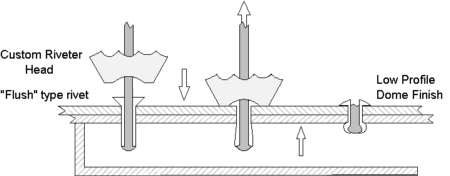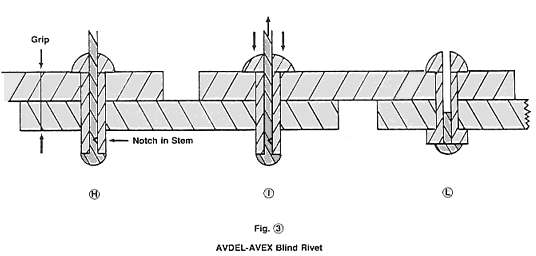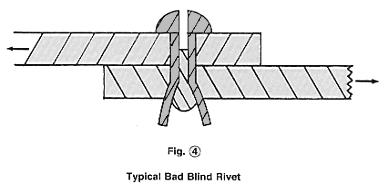By Chris Heintz, P. Eng.
[This article is part of a series, where aeronautical engineer Chris Heintz discusses light aircraft design and construction.]
In the first part of this article we examined the advantages (i.e. reliability and durability) of solid "bucked" rivets as well as their disadvantages (i.e. need for expensive equipment, required skill level, noisy operation, and accessibility). Blind rivets have been developed to overcome the disadvantages of solid rivets, and some of the blind rivets now available have retained virtually all the advantages of solid rivets. Let's look at blind rivets in some detail.
First of all, let us understand that a "pop" rivet is a blind rivet, but a blind rivet is not necessarily a pop rivet. ("Pop" rivet is a brand name manufactured by USM - United Shoe Machine - and obviously a "shoe" rivet is not ideal for aircraft use.)
As a typical example, we will use the Avex rivet (see Note at end of article).
When setting a blind rivet we first drill a slightly oversize hole so that the rivet can easily be inserted (see item H, Figure 3).
A special hand rivet puller (hand rivet gun from a local hardware store - at $15 to $50, depending on quality) is used to pull on the rivet stem and the reaction is applied to the rivet head. The stem has a special head which compresses the rivet tube and makes it grow and fill the hole (see item 1, Figure 3) pulling further. The rivet can only grow outside the parts until the rivet and stem head create a good formed head resting well on the part and squeezing the parts together. At that stage, the stem breaks in tension at the notch. (The set rivet is shown in item L, Figure 3.)
When we examine this blind rivet and compare it to the solid rivet discussed in Part 1 of this discussion, we find some of the same advantages:
- The rivet is manufactured under adequate quality control, which guarantees you the quality. (Again, see note at the end of this article.)
- The rivet fills the hole completely preventing any relative motion.
- Original and formed heads seal on and compress the parts together (no corrosion, the engine vibration loads do not fatigue the rivet because they are transmitted by friction.)
There is one prime disadvantage to blind rivets. The rivet, being tubular, has a section that is obviously smaller than that of a solid rivet. This means one blind rivet is not as strong as one solid rivet of the same diameter. The designer needs more blind rivets, a larger diameter rivet or a stronger material.
Many designers seem to like the "monel" (stainless steel type) rivets which are stronger, but they may forget that there is a corrosion problem involved with stainless steel. As mentioned in an earlier article, as the aluminum corrodes away, the aircraft owner has no choice but to replace the rivet with a larger diameter rivet later on. Or, if using stainless steel rivets, the builder has the messy burden of dipping every single rivet in zinc-chromate (ZnCr) primer before setting it in the hole ... and this is all beside the fact that there is no "good" stainless steel blind rivet readily available on the market!
Going to larger rivet diameters is a limited choice as the large blind rivets are so hard to set by hand that a very expensive and cumbersome tool is required. In my opinion, this defeats the purpose of these rivets in the first place.
Consequently, then, if the decision is made to go with blind rivets as opposed to solid rivets, the builder/designer is left with little choice other than increasing the numbers of rivets. A good rule to be used is that the number of blind rivets needs to be increased roughly in the proportion of 5 blind rivets for 3 solid rivets. In actual fact, this is not a consideration either on light airplanes as most rivets are used on the skins, which need a relatively small rivet pitch (spacing between rivets) anyway in order to prevent waviness in the skin panel. So, the designer is stuck, solid or blind rivets, not with the strength, but with choosing a pitch which provides a nice finish (for aerodynamic and aesthetic reasons).
We have given the example of the Avex blind rivet because this is the only reasonably priced "good" blind rivet readily available (see note). Cost of these blind rivets is just a fraction of the "Cherry" blind rivet (and, remember, you need 4,000 to 8,000 rivets per aircraft). One other very determinant factor for selecting these blind rivets is that they are "grip" insensitive. The standard Avex rivets will join from grip 0 to grip 1/4" (6 mm) with the same rivet. (This compares to four different lengths for the Cherry type). This is a very important factor to prevent errors and must bear heavily on the designer's decision to make construction as easy and reliable as possible for the builder.
There is one other objection to blind rivets. The rivet is okay for corrosion, but what about the stem? The stem is steel and phosphated, which is the correct protection, but, obviously, where the stem breaks there is no protection. Will this rust? Any galvanic corrosion protection (such as phosphating steel or zinc chromating aluminum) has a reach of about 1/8" (3 mm) beyond the protected area. With these blind rivets the broken part is only 1/16" at the most, and extensive experience has confirmed that this is not a problem. (Zenith CH 200 / 300 aircraft assembled with blind rivets still look like new after more than three decades, with outside storage.)
In this article we do not give any specific shear strength, just some relative values. It is the responsibility of every designer to obtain the values he or she feels can be consistently achieved by the builders (and this takes into account many things, such as basic design philosophy, materials to be jointed, working conditions, etc.)
Nevertheless, I feel impelled to warn some experimental designers that the shear values given by the blind rivet manufacturers in catalogues are to be looked at with some common sense as well. The manufacturer is not a liar, but he does present his product in the best possible way. For example, when they make tests they use very thin sheets so that the stem is long enough to fill the rivet (see figure 4), which is the reason why the individual shear strength is higher than an aircraft solid rivet (the steel stem participates). But on our aircraft, this is relatively seldom the case. As a rule of thumb, a reliable shear value should be 1/2 the catalog specification. But again, the designer should make tests. (Just as an example, when I do blind rivet tests, I knock the stem out before the test, just to be on the safe side!)
Figure 4 shows a bad blind rivet (a standard hardware "pop" rivet). Note that the rivet does not fill the hole and that there is note a nice, formed head (just the tube is opened); the stem will fall out after some vibrations.
Use the right rivets and you will be very pleased with the results!
Note: It is obvious that the notch depth in the stem is directly related to the breaking load. In previous years we used to recommend the Avex (brand) rivets, but outsourced manufacturing made it difficult to obtain the desired consistency. Zenith Aircraft now sources the rivets independent of brand name and makes a systematic test on every lot received to guarantee the correct quality, and supplies the blind rivets to customers worldwide. The FAA type-certificated ZENITH CH 2000 aircraft uses these same rivets.
|
![]()

Designer Chris Heintz has developed a unique method for setting Zenith blind (or pull) rivets: Using a "flush" type blind rivet (as opposed to a "dome" type), the rivet head is formed into a low-profile dome finish in the riveting (pulling) process, as illustrated above, with the use a of custom machined (concaved) rivet puller head. This simple process sets the rivet head tightly against the top skin while providing a low profile finish. More on blind riveting: EAA "Hints for Homebuilders" Video
|


